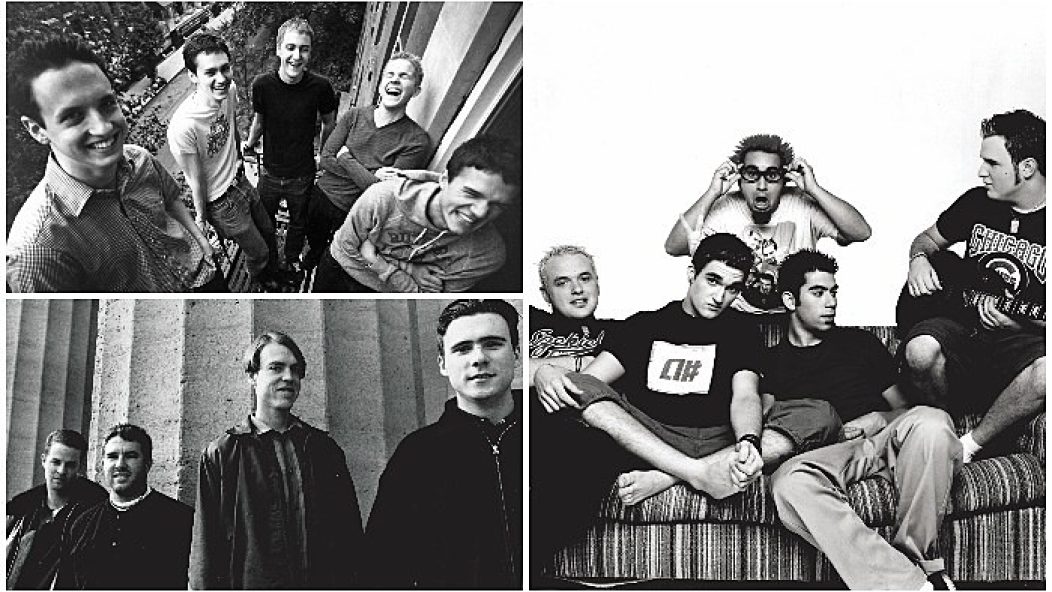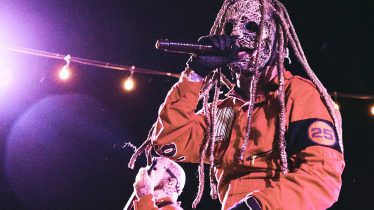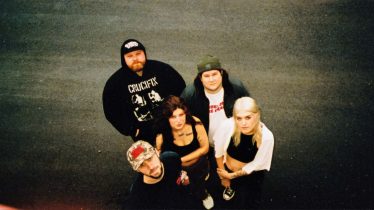
10 records from 1999 you won’t believe are two decades old
The new issue of AP features our annual “Class Of” special where we talk about the significance of records released 10 years ago. While some readers will certainly remember those selections, we decided to go back further to 1999. Ever wonder about records from, say, last century?
It turns out that 1999 was a pretty great precursor for indie-pop, the seeds of emo and the excavation of new horizons in technical metal and pop punk. Synthesizers were also made cool again. We understand some of these records are older than some listeners who visit this website. The main takeaway here is (as always): If you haven’t heard it, it’s new to you. If you were on these records the day they released in 1999, we’re glad to help you reconnect with them. Now then: sound up, eyes forward…
Read more: blink-182 have a punk-rock pep rally in “Darkside” video
1. A New Found Glory – Nothing Gold Can Stay
By the time a brash gang of South Florida teens called A New Found Glory (later shortened to New Found Glory) released their full-length debut, Nothing Gold Can Stay, in 1999, the high-velocity West Coast skate punk that had dominated the pop-punk scene for the past decade was primed for a makeover. As part of a burgeoning East Coast revival that also featured Saves The Day, Midtown and the Movielife, NFG instantly became a permanent car stereo fixture for scenesters, thanks to the band’s innovative and entirely irresistible fusion of punk melodies and hardcore breakdowns. For many, Nothing Gold Can Stay is the album where it all began.
Originally pressed in limited quantity early in the year by Eulogy Recordings before being reissued en masse by Drive-Thru that fall, Nothing Gold Can Stay captures the band at their hungriest and most raw; subsequent releases offer vastly improved sound quality, but the spirit and energy of the record set the gold standard (no pun intended) for everything that’s followed. After opening with the original version of the breakout single “Hit Or Miss,” Nothing Gold Can Stay rarely lets the listener take a breath, much less quit head bobbing, throughout its 12 tracks. As testament to its staying power, cuts such as “3rd And Long” and “2’s And 3’s” still work their way into NFG’s live set.
Read more: Every New Found Glory album ranked worst to best by guitarist Chad Gilbert
Although the group didn’t perfect their sound until 2000’s self-titled follow-up, the classic NFG hallmarks were already present: particularly guitarist Chad Gilbert’s ever-abundant riffage and singer Jordan Pundik’s earnest, unschooled vocal delivery which makes it one of his most endearing performances. Lyrically, the album is just as sincere—its tales of teenage romance gone awry could’ve been pulled straight out of any young punk’s life—yet it successfully walks the line between being emotive and cheesy.
“Nothing on it was premeditated,” Gilbert says. “Nothing Gold Can Stay was 100%, without a doubt, the most honest, simple, pure record. We were a bunch of kids who grew up in the suburbs, dating girls and talking shit about each other behind [each other’s] backs. We never thought we’d get anywhere, and I think that’s why people are drawn to it. The lyrics are very simple and honest, and the music is, too, and it’s not recorded that well. It sounds more real than a lot of other records.” —Brendan Manley
2. The Dillinger Escape Plan – Calculating Infinity
It’s hard to comprehend in our present era of genre-cross-pollinating information overload, but when the Dillinger Escape Plan recorded Calculating Infinity in the spring of 1999, making a hyper-technical metal album still seemed like a novel idea. As the only quintet of short-haired, middle-class suburban dudes on Relapse Records, Dillinger had to play that much harder, tighter and faster to earn the respect of underground metal’s cognoscenti. But after Calculating Infinity’s release, no one was questioning the band’s veracity—or velocity—anymore.
With Calculating Infinity, the band smashed the hardcore barriers of their early EPs with a vocabulary whose frenetic, quick-changing violence would set the tone for 10 years’ worth of other bands’ best ideas. Arguably ground zero for contemporary math-metal, Calculating infinity opens with the surgically precise thrashing of “Sugar Coated Sour” and continues its assault through the harrowing movie samples that close the album. You can still hear a tenuous line to Dillinger’s hardcore days in then-vocalist Dimitri Minakakis’ roar, as well as in the longtime live staple “43% Burnt” (the closing of which houses one of the most complicated breakdowns in heavy-music history), but it’s the metallic filigree that filets your brainpan.
Read more: The Dillinger Escape Plan crush the first of their three final shows—watch
“[Metal] was a smaller subculture back then,” guitarist Ben Weinman remembers. “It was very hard to get accepted. We had to create a niche for ourselves—even our peers at the time didn’t sound like us. I remember going into Calculating feeling like I was about to define what I was going to do for the rest of my life.
“We had so much less technology at our disposal than we do now,” he continues. “There was no Pro Tools, no punch-ins. I remember both me and Chris [Pennie, former drummer] pushing each other; him being like, ‘I can’t play this any faster,’ and me going, ‘We have to play it faster,’ because not only did we want to be clever and technical, [but] we wanted to have energy and emotion. So by the time we got in the studio, it was twice as fast, and by the time we got onstage, it was twice as fast as that. [Laughs.] It really was an exercise in pushing ourselves and realizing that anything we set our minds to do, we can program into our limbs.” —Aaron Burgess
3. The Dismemberment Plan – Emergency & I
The Dismemberment Plan were already five-year veterans of the Washington, D.C. music scene when they signed with Interscope Records in 1998. But after releasing just one promotional EP on the major, the band became victims of a corporate merger and were dropped—even though they had a J. Robbins/Chad Clark-produced full-length, Emergency & I, completed and ready to go.
Musically, Emergency was the perfect bridge between the math-rock whirlwinds of 1997’s Is Terrified and the subdued atmospherics of 2001’s Change, finding cohesion in sonic chaos. Emergency proved that D.C. bands could transcend the city’s post-hardcore reputation, and it directly inspired Q And Not U, Enon, So Many Dynamos and Les Savy Fav. The Plan even influenced early Death Cab For Cutie (the two bands famously shared bills on 2002’s Death And Dismemberment tour). However, the biggest testament to Emergency’s legacy is its fans: You’d be hard-pressed not to bond instantly with anyone who loved the album, saw the band in their heyday or had a riotous bedroom dance party to their tunes.
Read more: Death Cab For Cutie drop tribute to 1999 pipeline explosion victims
“I remember how excited we were [making it],” frontman Travis Morrison says. “[Recording Emergency] was an experience of actually putting in a large chunk of time to make a record, which was a first for us. Our previous record, [Is Terrified,] had been made in four days. We felt like we’d gotten very, very close to what we wanted to do with our previous record, but didn’t quite get it right. And [we] also had a little bit of a chip on our shoulder.”
Morrison confirms that while Interscope kept their part of the deal, he played “the artist” card. “We had a two-record guarantee deal, [and] they actually came through with their side of the bargain and gave us the money for the next record that was never recorded,” he says. “Part of our legend is that we got screwed over by this major label. I went with it for a while, because it sounded good to the press. [Laughs.] But it was good to us.” —Annie Zaleski
4. The Get Up Kids – Something To Write Home About
Following a few endearingly lo-fi seven-inch singles and the promising (if hurried) debut full-length Four Minute Mile, no one could have predicted that a year spent in major-label limbo would lead a group of unassuming Lawrence, Kansas, punks to a genre-defining classic.
Read more: Watch the Get Up Kids perform a full set in 1999
Something To Write Home About is the record which, along with Jimmy Eat World’s Clarity, brought emo to the peak of underground success, carrying it past the post of its hardcore roots and combining it with an aggressive power-pop drive that would be copied for years to come. It was also the band’s first album with full-time keyboardist James Dewees, who did double-time as the drummer in influential metalcore group Coalesce—and who earlier the same year released Greatest Hits ’84-’87, the just-as-essential debut album by his alter ego, Reggie And The Full Effect. It’s impossible to imagine “Ten Minutes,” still one of the Get Up Kids’ best-loved songs, without Dewees’ memorable keyboard-led rave-up or the gentle “Long Goodnight” without its subtle piano accents. If you’re looking for an album to fall in love, break up and fight the man to, you probably already count this as one of your favorites.
“I don’t really listen to any of my records,” frontman Matt Pryor says. “But when we started doing these Get Up Kids [reunion] shows, I had to go back and listen to it again. Some of the stuff was a little more creative than I remember it being. I don’t think it’s the best thing any of us have ever written. I think there’s some great stuff on it, but it’s like, ‘Oh, that’s the one you like? OK, cool.’” —Sam Sutherland
5. Hot Water Music – No Division
When Hot Water Music emerged from the swamps of Gainesville, Florida, in the mid-’90s, no one knew what to expect. Sporting epic beards and brandishing battered Les Pauls, the band—equally influenced by Chicago punks Pegboy and literary icons such as Charles Bukowski (the group got their name from one of his collections of short stories)—combined elements of punk, rock and early emo to forge a completely new sound on their early albums. Just as it looked like they would transcend the underground scene, the group broke up in 1997. Thankfully, it didn’t take: The band reformed shortly afterward and began work on their third proper album, No Division, a disc that saw this rejuvenated band of brothers fully realizing their melodic potential.
Read more: Trailer for Cole Sprouse’s first movie since 1999 will make you emotional
Produced by hardcore legend Walter Schreifels (who was a partner in the band’s new label, Some Records), the disc was Hot Water Music’s first serious studio recording. While the group’s rhythm section had a tendency to show off in their early days, “Free Radio Gainesville” and the title track are jaw-droppingly technical without being superfluous and proved to be the perfect backdrop for the band’s motivational musings. On paper, lyrics such as “Live your heart and never follow” (from “It’s Hard To Know””) may seem cheesy, but when you hear the passion inherent in every note of No Division, it’s impossible to doubt the band’s sincerity—and that’s probably why the album still sounds as relevant today.
Vocalist/guitarist Chuck Ragan credits the band’s hiatus with giving them the clarity to make No Division. “I think when we took a step away from everything, we really were able to reevaluate a lot more about why we were doing this, so I know we were all a hell of a lot more focused going into No Division,” he points out. “You can really tell just by listening to it.” —Jonah Bayer
6. Jimmy Eat World – Clarity
After a commercially disappointing major-label debut, Arizona-based Jimmy Eat World returned with a brilliant album, the likes of which the scene had never experienced before. On 1996’s Static Prevails, guitarists Tom Linton and Jim Adkins split vocal duties and delivered brash, aggressive songs influenced equally by early-’90s pop punk and first-wave emo. But when writing the follow-up, Clarity, the band opened themselves to a whole new world of sounds, from lush string sections (“Just Watch The Fireworks”) to delicate bells (“A Sunday”) to drum loops (“Lucky Denver Mint”) to esoteric electronic programming (“12.23.95”)—things none of their contemporaries were even contemplating at the time. Adkins also assumed the mantle of frontman, penning and singing 12 of the album’s 13 songs. (However, Linton’s lone contribution, the powerful “Blister,” remains one of the band’s best-loved songs.)
Read more: Watch Jimmy Eat World’s full 1999 Warped Tour set
In the months following Clarity’s late-winter release, modern-rock radio was dominated by Sugar Ray’s “Every Morning” and Lit’s “My Own Worst Enemy”—simple songs suited for mass consumption. In retrospect, Clarity, with its complex arrangements (“Your New Aesthetic”) and so-earnest-it-hurts lyrics (“For Me This Is Heaven”), never stood a chance with the mainstream. But like Weezer’s Pinkerton before it, the album has gone on to serve as the birthplace of emo’s third wave: The 16-minute closing track “Goodbye Sky Harbor,” with its organic breakdown/electronic buildup, has been often imitated but never duplicated, proving once more that it’s far better to test your own limits than rely on the parameters of others—which is the exact reason why Clarity resonates with tens of thousands of people, a decade later.
“Our A&R person at the time, who was the only liaison between us and the label, came down once to listen to stuff,” Adkins recalls. “He didn’t stick around very long, and we didn’t really get into talks at all. At the time, I thought it was kind of a sign of them not being interested, but now I’m thinking that was kind of smart—what you would hope for in a label. We were left totally alone to do whatever we wanted. There was no conversation about making something catchier to get on the radio or trying to conform to whatever else was popular at the time.” —Scott Heisel
7. Poison The Well – The Opposite Of December: A Season Of Separation
When Poison The Well started writing The Opposite Of December: A Season Of Separation in early 1999, their goals were incredibly simple. The band wanted to play shows outside Florida and sign to Trustkill Records, lofty ideals considering that four-fifths of the band were still in high school, and they only had an EP to their name.
With clattering breakdowns, collapsing bridges and a metallic slant, the band replicated some of their peers’ DNA, but the romance, heart and soul thrown chaotically into their raging hardcore soon separated them from the scene’s repetition. The ethereal, anguished yet hopeful lyrics elevated “Nerdy,” “Artists Rendering Of Me” and “Slice Paper Wrists” from songs to anthems. Poison The Well’s emotive, melodic tendencies were embraced by many who were desperate for what the band had to offer. The lush interludes, spoken-word sections and actual singing demonstrated creativity, ambition and fearlessness that alerted larger labels to the potential of the young Floridians. (They would eventually become one of the first modern metalcore bands to sign with a major label.) Without intending to, Poison The Well forever changed the face of hardcore.
Read more: Apparently an 11-year-old Skrillex stage dived at Metallica’s 1999 symphony performance
“At the time, we just wanted to sound different and really heavy, but not lack in any sense of melody or romance,” guitarist Ryan Primack says. “We still wanted those things to be present in what we did. I look back and think of it as a very positive experience of us not knowing what the hell we were doing but doing it anyway. I’m proud that I helped make a record that had an impact in any way. I’m also proud of the fact that we made something that maintained its innocence.
“Nobody really knew it was going to do anything or work in any way, but it just did. We were five kids from the hardcore scene existing in the hardcore scene. We were just regular dudes.” —Andrew Kelham
8. Saves The Day – Through Being Cool
Once they got through the growing pains of their shamelessly Lifetime-saluting debut, 1998’s Can’t Slow Down, Saves The Day were able to redefine modern pop punk with 1999’s Through Being Cool. Thanks to the discovery of more midtempo-minded bands such as Jawbreaker and Foo Fighters, frontman Chris Conley learned to explore his youthful concerns with subtle hints of restraint and greater atmosphere while delivering his heartfelt admissions in a supremely melodic form. Producer Steve Evetts, having then worked primarily with hardcore bands such as Deadguy, Ensign and Snapcase, coated the recording with the perfect mixture of grit and gloss.
Through Being Cool became an East—and eventually West—Coast manifesto, inspiring wave after wave of pop-punk and hardcore bands. It might have eerily foreshadowed the more radio-ready and girl-concerned pop punk that would spring up after the turn of the millennium, but it still ached and swelled just as sincerely as Lifetime’s Ari Katz and Jawbreaker’s Blake Schwarzenbach had throughout the maturing punk underground of the ’90s.
Read more: This ‘It: Chapter Two’ actor modeled on Saves The Day’s album cover
“I remember in the van at the time,” Conley begins, “driving between shows, we’d listen to Refused’s The Shape Of Punk To Come [and] Foo Fighters’ The Colour And The Shape pretty much nonstop. I think those two records are basically the reason that we slowed down. I don’t at all take offense when people say, ‘Those were your best years’ or whatever, because I understand that music that you grow to love when you’re younger just stays with you. It’s all perspective and opinion and taste.
“I think it’s cool that a band like Fall Out Boy literally started as two separate Saves The Day cover bands, and they auditioned Patrick Stump to be [the] singer of Fall Out Boy by having him play Through Being Cool in its entirety. That is a crazy thing, right? The biggest emo band in the world started as a Through Being Cool cover band. I’m very proud of that.” —Brian Shultz
9.The Faint – Blank-Wave Arcade
The Faint, Bright Eyes and Cursive made Omaha, Nebraska, hallowed musical ground, but only one of the three acts revived keyboard cred in the process. After 1998’s Media, the Faint’s straight-ahead indie-rock debut, the group took stock of the scene. Hardcore wasn’t moving forward, and guitar-based avant rock seemed played out, so they added keyboardist Jacob Thiele to begin a new approach cloaked in pre-millennium machinery. What emerged was Blank-Wave Arcade, a glitzy, stylized idea of punk with its backbone in crushing synth melodies; and Todd Fink (né Baechle)’s distorted voice and pulsating drums and bass—courtesy of Todd’s brother Clark and Joel Petersen—as its flopping appendages. The band’s updated new-wave aesthetic paired with a live presence (complete with fog, strobe lights and even priest collars) forced hipsters and punks alike to uncross their arms and shake their asses.
Read more: Good Charlotte release never-before-seen live footage from 1999 show—watch
Fleshed out from an EP of strictly sex-themed synthesizer tracks, these nine songs leave no room for filler in a fast-paced, dystopian-meets-Dionysian 25 minutes. Fink is at his most clever in “Worked Up So Sexual,” a song about strippers tucked into a pink G-string of pole-dance pop. On the other stylistic coast is the minimalist industrial piece “Sealed Human” (drawing its whirring influence from the 1978 English post-punk single “Warm Leatherette” by the Normal) which depicts the bleakness of modern public transit. Guitars weren’t completely scrapped on Blank-Wave, and “In Concert” is better for it with Petersen’s hook leading an ode to the ramshackle house shows the Faint would soon outgrow.
“We found out what we were after making [Media],” Fink explains. “We felt too similar to all of the bands we were playing with, and we didn’t really like those bands. We were under the impression that any sound could be created on a synthesizer. Since they weren’t cool at all at the time, that made it even better. We were sure to sound like no other band. We never thought of ourselves as making dance music. More like we stopped making boring music.” —Reed Fischer
10. The Stereo – Three Hundred
These days, Fueled By Ramen may be a breeding ground for stars, but in the late ’90s, the label was home to a handful of underground punk and ska bands. When two of three bands—Animal Chin and the Impossibles—split up and their songwriters—Jamie Woolford and Rory Phillips, respectively—were gearing up to work on solo records, FBR co-founder John Janick suggested that they team up instead. Less than 24 hours later, Woolford was on his way from Minneapolis to Austin, Texas, to meet up with Phillips, and the Stereo (named after the two representing the left and right sides) were born.
Mere months later, Three Hundred was released. It may have been recorded in a basement that reeked of cat piss, but it sounds ready for an arena: The yin of Woolford’s unabashed love of ’80s radio hits plays off the yang of Phillips’ geek-rock songwriting to make a power-pop record with surprising staying power. After the bizarre drum patterns of “Dance To This!” comes the simple driving beat of “Drop Everything.” When the big hooks of “Ramona” start to feel too oversized, the tiny falsetto vocals and droning piano dissonance of “Problems” swings the pendulum the other way.
Read more: 10 Slipknot tracks that don’t fit in with the rest of their catalog
Although their musical styles seemed to mesh perfectly, their clashing personalities caused the duo to split up shortly after Three Hundred’s release. The Stereo continued Phillips-free for two more full-lengths before imploding in 2004. But in 1999, it was uniquely inspiring to see two small-city punks swinging for the fences and hitting their mark without studio trickery or clever marketing—only with great songs.
“It was a piss-poor relationship at the time,” Woolford says. “We’ve since become friends again, but man, it was lame. It was not fun. It’s never fun to be stuck in a car with someone who you don’t like and you know they don’t like you. I wanted to kind of bail out, but I felt obligated to John [Janick]. He had taken a chance on this idea. We were probably very quick to do all the stuff we’d done. By the time we had agreed to do the project and by the time the record actually came out, it couldn’t have been more than three months.”
The duo even had their own indie mythology, purportedly turning down a million-dollar deal from Interscope. Woolford laughs. “Not at all,” he says. “But, if I were to say that was true, that would make me so much more punk, wouldn’t it? I did accept a very, very expensive salad from Grand Royal Records.” —Luke Jaxon
This feature originally appeared in AP #254 with cover stars A Day To Remember. The issue is available now here.








